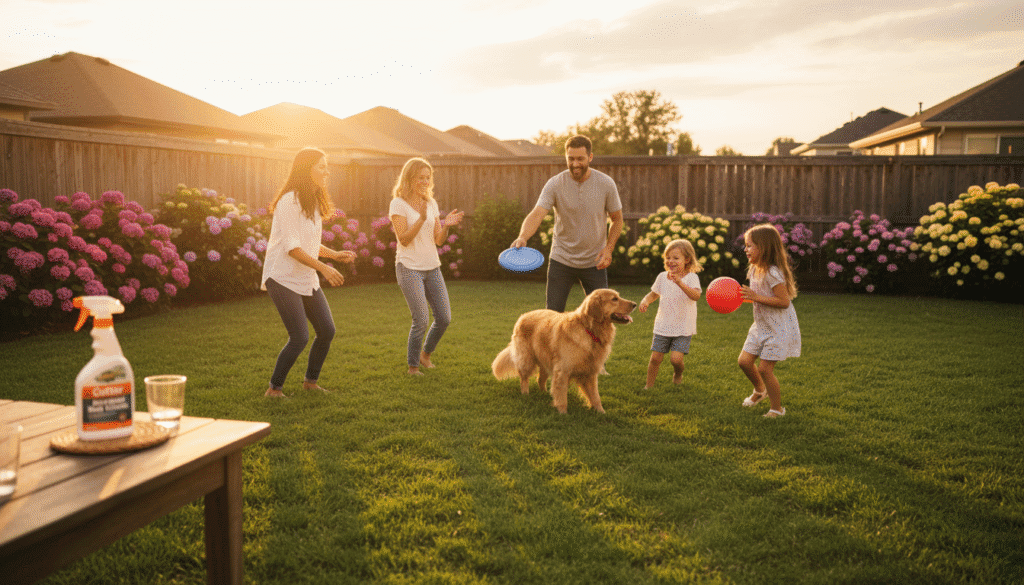You know how summer evenings are magical the air warms, you hear crickets, maybe a gentle breeze rustles leaves. But then come the bugs. Mosquitoes buzzing, ants showing up at your picnic, ticks lurking in tall grass. I used to hate inviting people into my backyard because it turned into bug central. Then I found cutter backyard bug control and things changed. But of course, being a parent (or pet-owner) I worried is it safe? Will it harm my dog? Will the kids get sick if they run through the yard after I spray?
Over time I dabbled, read labels, made mistakes, got advice and now I feel confident enough to share what’s worked (and what to watch out for). So here’s a friendly walk through everything you need to know about cutter backyard bug control, how to use it safely, and how to get results without endangering your loved ones.
What Is Cutter Backyard Bug Control?
At its core, cutter backyard bug control is a homeowner insect control product meant for outdoor use around yards, patios, gardens, and fences. It comes in several forms:
- Spray / spray concentrate: A liquid you dilute (if concentrated) and spray over surfaces, soil, foliage.
- Fogger / insect fogger: A formulation that emits fine mist or fog to drift across wide areas.
- Ready-to-use sprays: Pre-diluted, no mixing required.
The active ingredients often include pyrethroids (synthetic versions of natural insecticides) that target a broad variety of insects mosquitoes, ants, fleas, ticks, spiders. These compounds interfere with insects’ nervous systems, ultimately killing or repelling them.
When used properly, cutter backyard bug control spray concentrate can deliver strong protection across your yard. And the fogger versions let the mist drift into shaded or hard to reach spots.
Why Use It in Your Backyard?
There are a couple of reasons people turn to something like cutter backyard bug control:
- Pest pressure: If mosquitoes, fleas, ticks, or ants are bothering you, your family, or your pets, you want relief.
- Disease risk: Mosquitoes transmit diseases (depending on region). Ticks can carry Lyme, etc.
- Comfort & enjoyment: You don’t want bug bites to wreck your outdoor BBQ or relaxing evening outdoors.
- Prevention: Even before things get bad, treating your yard can stop insects from breeding.
But it’s not a silver bullet. It won’t eliminate all pests forever. Weather, coverage, and environment all matter. That’s why knowing how to use it safely and smartly is key.
How to Use Cutter Backyard Bug Control Safely (Step by Step)
Using it recklessly is where harm (to pets, kids, environment) creeps in. Here’s a natural, cautious way I apply it in my yard you can adapt to yours.
Step 1: Read the Label First
Yes, even though we often skip it. But the label gives crucial information — dilution rates, how much area the concentrate covers, warnings, safe reentry times, etc. Always follow that.
Step 2: Choose the Right Day & Time
- Pick a cool, calm morning or evening — avoid midday heat or direct sun.
- No rain predicted for at least 24 hours (so your treatment isn’t washed away).
- Low wind (less than ~10 mph) so spray/fog doesn’t drift off target.
Step 3: Prepare & Dilute If Needed
If using cutter backyard bug control spray concentrate, mix with water as per directions. For example, the label might recommend 1 oz per gallon or similar measurements (check product version). Stir gently, don’t shake violently.
Step 4: Gear Up & Protect Yourself
- Wear gloves, long sleeves, long pants, closed shoes, maybe a mask if doing fogger.
- Keep kids and pets indoors while applying and for the safe reentry period (see label).
- Cover or remove bird baths, fish ponds, pet dishes, toys, etc.
Step 5: Apply Methodically
- For spray: begin at one corner, move steadily, overlap slightly, cover low foliage, soil, edges.
- For fogger: set fogger in central location, activate, then withdraw. Let fog drift into shaded corners, under decks, etc.
Step 6: Wait & Let It Dry / Settle
You’ll often see a waiting time on the label (for example, 4 hours or more). Don’t let kids / pets back during that. After that period, you can re-enter.
Step 7: Reapplication (if necessary)
Under heavy pest pressure or if it rains, you might reapply after a few weeks (often 14–21 days), but never more often than label allows.
Safety Considerations & Pet / Kid Safety
This is where I had the most worry (and made mistakes). But if you treat it respectfully, you can reduce risk.
What “Pet Safe” Really Means
When a product claims cutter backyard bug control pet safe or safe for pets, it usually means that following label instructions, letting it dry, and adhering to reentry time keeps risk low. It’s not a guarantee of zero risk.
Precautions Before / After Application
- Keep pets indoor or away during application and until safe reentry.
- Don’t spray directly on pet toys, bedding, food bowls, water bowls.
- After the waiting period, if floors/grass seem wet, wait longer or avoid those spots.
- Monitor pets for any signs of irritation, vomiting, drooling — call vet if concerned.
- Don’t let kids run through spray mist as it’s settling.
Special Cases & Vulnerable Conditions
- If anyone in your household has respiratory sensitivity or asthma, extra care.
- If your yard has beneficial insects (bees, butterflies), avoid spraying blooming flowers.
- Don’t let runoff reach storm drains, ponds, or waterways.
In my experience, letting everything dry thoroughly and delaying reentry is the biggest safety net.
Effectiveness & Limitations
Here’s what to realistically expect from cutter backyard bug control:
- It works best where you can reach surfaces (shrubs, fences, ground cover).
- Strong protection might last 2–4 weeks under ideal weather.
- Heavy rain, sprinkler systems, or irrigation can wash it away prematurely.
- It doesn’t offer 100% kill — some insects hide deep.
- It’s not effective if insects are breeding right next door (you might need neighbor cooperation).
I remember spraying one weekend; a sudden downpour came the next day, and many mosquitoes returned. That taught me to always check the forecast first.
Spray vs Fogger vs Other Methods
Let’s compare:
| Method | Pros | Cons | Best Use |
|---|---|---|---|
| Spray (liquid) | Direct contact, more control | labor, might miss shadows | around fence, bushes, garden edges |
| Fogger / insect fogger | Covers wide & hidden areas | drift risk, won’t stick on surfaces | large yards, dense shrubs |
| Other methods (traps, larvicides, physical removal) | low chemical exposure, targeted | slower, limited coverage | small zones or supplemental use |
If your yard has thick shrubs or clutter, a fogger helps. For targeted areas (playset, dog run), sprays do better.
Real-Life Tips & Tricks I’ve Learned
- Evening application is better — insects tend to rest, surfaces cooler.
- Focus on shady, humid spots — that’s where bugs hide.
- Do a border barrier first — treat the perimeter of the yard to block entry.
- Remove standing water — no point spraying if mosquitoes breed in buckets, gutters, or old tires.
- Trim tall weeds / grass — reduces hiding spots and improves spray reach.
- Spot treat in between full applications — a quick mist in a problem area helps in a pinch.
Once I started doing all of that together, the effect of cutter backyard bug control was much better — bugs were scarce, my family could enjoy evenings outside, and I wasn’t respraying every few days.
Example / Anecdote: My Backyard Battle
Last summer, I invited a few friends over for a barbecue. Two days prior, I sprayed my yard with cutter backyard bug control spray concentrate, following the guidelines. I mixed carefully, applied late evening, kept kids and pets inside, and waited 5 hours before letting anyone out.
That night almost no mosquito bites. My kids played barefoot, my dog ambled around, and the adults sat chatting under string lights. A week later, after heavy rain, a few mosquitoes crept back — I spot-sprayed the corners and got control again.
I’ll admit: first time I messed up. I sprayed full sun at noon. Within hours the heat had evaporated much, and bugs returned fast. Learned the hard way: time of day matters.
FAQs
Is Cutter Backyard Bug Control safe for pets and kids?
When used exactly per label waiting until surfaces are dry, observing safe reentry periods, and preventing exposure during application it can be reasonably safe. But it’s not risk-free, so caution is key.
How do you mix Cutter Backyard Bug Control spray concentrate?
Follow your specific product’s instructions. A common ratio might be 1 oz concentrate per gallon of water but always check your bottle’s label to avoid under- or over- dilution.
Can you use Cutter Backyard Bug Control fogger inside?
No foggers for “backyard” use are designed for outdoor use. Indoor foggers are specially made for enclosed spaces. Using a backyard fogger inside risks overexposure and danger.
How long after applying can you let pets/kids back outside?
That depends on the product often 4 to 24 hours. Always check the label. If surfaces are still wet, wait longer.
How often should you reapply Cutter Backyard Bug Control?
Under normal conditions, every 2–4 weeks. After heavy rain or watering, you may need to reapply earlier (if label allows). Never apply more frequently than recommended.
Does it kill mosquitoes, ticks, fleas, etc.?
Yes, it is designed to target a range of insects mosquitoes, ants, ticks, fleas, spiders depending on formulation and concentration.
What’s the best time to apply Cutter Backyard Bug Control?
Early evening or early morning (cooler, calmer air) is ideal avoid midday heat and direct sun.
Are there natural or organic alternatives?
Yes products with essential oils (e.g. citronella, lemongrass) or microbial larvicides (Bacillus thuringiensis israelensis, Bti) can help. But they often need more frequent application and may be less powerful.
Final Thoughts
I started using cutter backyard bug control because I got tired of scratching hundreds of mosquito bites and avoiding my own yard. Over trial and error, I figured out that the secret isn’t just the chemical — it’s how, when, and where you use it (plus common sense safety). If you treat it respectfully, follow label instructions, and combine it with smart yard practices (removing water, trimming vegetation, checking weather), you can enjoy a pest-lighter backyard without undue risk to your kids or pets.
Go ahead and try it carefully. Keep notes: how many bugs before, after, when reapply. You’ll develop your own yard routine. Your evenings outdoors can come back.


